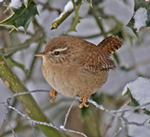Roosting survey: winter 2010–2011
It was a dramatic winter with plenty of snow and ice, which included the coldest December in a century. Many birds responded as expected, flooding into gardens to feed – and also to sleep.
It seems that our gardens are ideal places for many birds to spend the night. Urban areas tend to be that bit warmer than those in the wider countryside and people also provide lots of cosy hidey-holes in which birds can bed-down for the night. Some of these holes are provided intentionally, through the provision of nest boxes and roosting pouches, and some not, when birds find a crevice around your house!
Big response
Over 400 people took part in the survey, with around a quarter searching for droppings, over a third using nest box cameras, and more than half making direct observations of birds flying to or from a roosting site. Each of these approaches revealed subtly different and valuable results.
Some intriguing differences in the roosting patterns of different species have emerged through the survey. Clearly, some species, such as Blue and Great Tits, are fairly antisocial sleepers, with most individuals roosting alone. Others, however, are much more likely to bed down in groups, with House Sparrows and, in particularly, Wrens often roosting in large numbers. Indeed, Wrens were the real superstars of the survey with a maximum count of 51 individuals found roosting together near Lyme Regis, Dorset.
The diversity of birds that roosted in gardens was impressive, with 12 species detected through the survey. Although some participants were lucky enough to see more than one species roosting on their patch simultaneously, in order to display the main findings in the most understandable way possible, the following results focus on the first species recorded by each survey participant. This provides a comprehensive overview of the exciting goings on in winter 2010.







Share this page